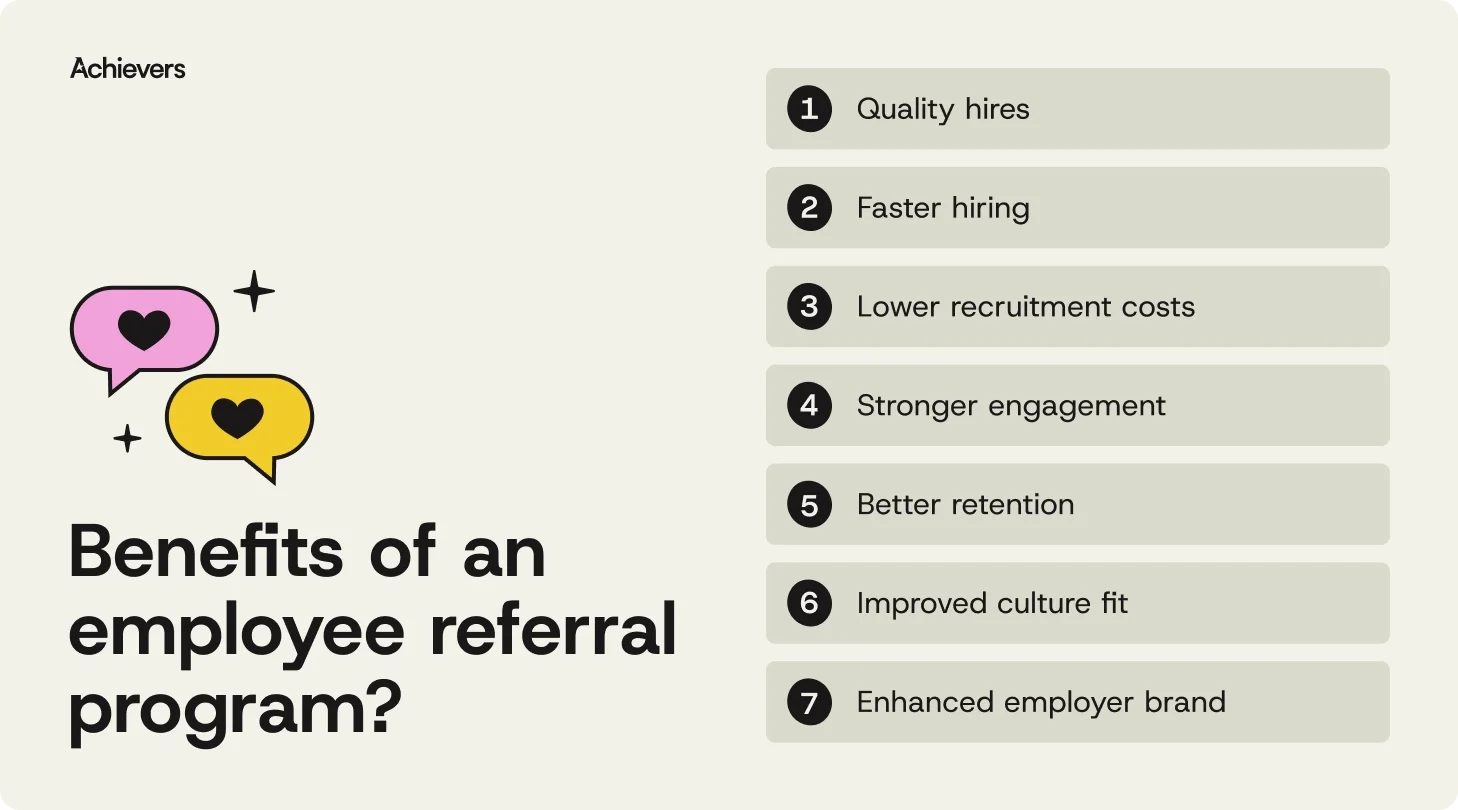Table of contents
Create a culture that means business™
Schedule a demo with an Achievers solution expert today.
Employee referral programs have long been a recruiter’s best-kept secret — but the secret’s officially out. In a job market where quality talent can feel like a moving target, referrals are proving to be a shortcut to better hires and stronger retention.
And the payoff isn’t just in headcount — it’s in results. According to ZipDo, referred employees are 25% more profitable than those hired through other sources. That’s not just a better pipeline — that’s impact you can measure.
But here’s the kicker: recognition is what makes referral programs stick. When employees are celebrated for helping shape the team — not just completing their own tasks — it builds pride, motivation, and long-term engagement. A quick shout-out, a meaningful reward, a moment of appreciation — it all adds up.
Ready to build a referral program that does more than fill seats? Let’s break down what it is, why it matters, and how recognition can take it from helpful to high impact.
What is an employee referral program?
An employee referral program is a structured way to source strong candidates through the people who know your company best — your team. Instead of relying solely on job boards or recruiters, you ask current employees to recommend people they know and reward them when those referrals turn into hires.
Why does it work? Because your employees already get your culture. They know what it takes to succeed in your environment, which makes them well-equipped to spot someone who’s likely to be a great culture fit.
Why is an employee referral program important?
Let’s face it: finding the right candidate isn’t always easy. But employee referrals? They give you a head start. Referrals are faster, more personal, and built on trust — which makes them one of the smartest ways to hire and keep top talent.
Here’s why they’re worth leaning into:
- They help you grow without losing your culture: When employees refer people they trust, you’re not just hiring for skills — you’re hiring for shared values. That means faster onboarding, fewer bad fits, and a culture that stays strong as you scale.
- They boost trust and pride: Referrals say, “I believe in this place enough to bring someone in.” Recognizing that kind of buy-in builds deeper loyalty — and turns your people into champions of your brand.
The benefits of an employee referral program
Great people know great people — and a well-run referral program makes it easy for your employees to bring those people in. It speeds up hiring, cuts costs, and brings in candidates who are more likely to stick around for the long haul.
Here’s why referral programs should be part of every talent strategy:

- Higher-quality hires: Referrals tend to be stronger fits for both the role and your culture — because your employees know what it takes to succeed.
- Faster, more efficient hiring: Skip the long list of unqualified resumes. Referrals streamline the process and save valuable recruiter time.
- Lower recruitment costs: No agency fees. No expensive job ads. Just better hires, faster.
- Stronger employee engagement: Involving employees in hiring gives them a sense of ownership in shaping the team — and they appreciate the recognition that comes with it.
- Better retention: Referred candidates are more likely to stay because they’ve already got a built-in connection to your company culture.
- Improved cultural fit: When your people refer others who “get it,” your culture stays strong as you scale.
- Enhanced employer brand: A thriving referral program signals that your employees want others to work there — and that says a lot.
How to create an employee referral program
Referral programs don’t have to be complicated — but they do need structure. Here’s how to build one that’s easy to manage, easy to promote, and can help deliver impactful results:
1. Start with a plan
Before you launch, zoom out. What’s the goal? Are you trying to fill tough roles, speed up hiring, or scale culture without losing what makes it great?
Get clear on which roles need referrals, what a great candidate looks like, and what success means for your team. The sharper the plan, the stronger the results.
2. Set clear rules (and stick to them)
No one wants to guess how a referral program works. Lay it out: how to submit, which roles qualify, and when rewards are earned — whether it’s at the time of hire or post-probation.
Then make it visible. Track participation and celebrate publicly (yes, even if the candidate doesn’t get hired). Recognition in real time helps reinforce the behavior you want more of.
3. Promote the program — and recognize along the way
Even the best referral program won’t go far if no one knows it exists. Promote it often: in team meetings, manager 1:1s, internal communications — and yes, your recognition program.
Just as important? Celebrate participation from the start. A recognition platform like Achievers makes it easy to spotlight referrals as they happen, tie recognition to milestones, and send rewards that mean something. That’s how you build a culture where contributing to company growth actually feels good.
4. Mix up your employee referral incentives
Let’s be honest: no one’s going out of their way for another company pen.
Keep engagement high with rewards that actually motivate. Use a tiered points system to recognize every stage — from submission to hire — and let employees choose what’s meaningful to them: a wellness day, new tech, or that conference they’ve been hinting at in every 1:1.
The more personal the reward, the more likely they are to keep referring.
Connect referrals with recognition
Recognition is what keeps your referral program from becoming a ghost town. It reinforces effort, rewards initiative, and tells employees, hey, we noticed. And that matters — a lot. According to the 2024 Engagement and Retention Report, 51% of employees recognized at least monthly rarely think about job hunting. That’s one less resume floating out into the world.
Here’s how to build recognition into your referral flow:
- Shout it out early: Celebrate every referral, not just the ones that make it to day one. It keeps the energy up and shows that effort counts, not just outcomes.
- Make rewards feel worth it: A points-based system lets employees pick what motivates them most, whether that’s a wellness day, a new gadget, or finally splurging on that espresso machine.
- Put recognition on display: Public praise does more than boost the person who gets it — it nudges everyone else to jump in, too. A quick shout-out in a team meeting or your company’s recognition feed keeps referrals visible and valued.
Bottom line? People want to feel appreciated, especially when they’re helping build the kind of workplace they’re proud to refer others to.
Referral programs are great. Recognition makes them unstoppable
Employee referral programs are one of HR’s best-kept cheat codes. They bring in better candidates, faster — and from people who understand what it takes to succeed on your team. But the real value isn’t just in who you hire — it’s in how employees feel when they help shape the team.
That’s where recognition comes in. A thoughtful thank-you, the right reward, a bit of public appreciation — it all adds up. When employees feel seen for their contribution, they stay engaged, stay motivated, and keep the referrals coming.
Achievers helps you build that kind of program — one that recognizes every referral, rewards every effort, and keeps your culture growing in all the right ways.


